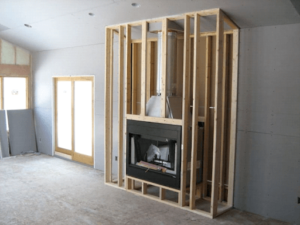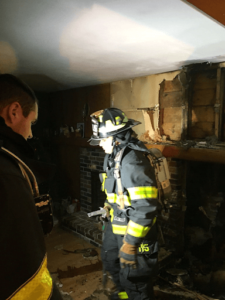Prefabricated metal fireplaces became popular in the 1970s as an inexpensive alternative to building a masonry fireplace. They were targeted to homeowners who desired to have an open burning decorative fire on an occasional basis. They were NOT intended to be a primary heating source or to have a wood burning insert installed into them.
Along came the oil shortages of the late 1970s and many homeowners tried to push the limits of their capability; they tried to stuff them full of wood to create more heat and burned them continuously for days or weeks at a time, hoping to provide supplemental heat or reduce home heating oil bills.
Whether you’re the original owner of one of these older homes or have recently moved into one, it’s essential that you have the prefabricated wood burning fireplace and chimney thoroughly inspected every year, especially since many of them were overfired in earlier decades, presenting fire safety issues.
Of great concern is the fact that older models are now approaching 30 to 50 years old and causing a considerable number of house fires. While a masonry fireplace may last as long as the house stands, a prefab wood burning fireplace is considered (by industry standards) to have a lifespan of 10 to 30 years.
Prefab decorative wood burning fireplaces are made of relatively light-weight metal; precast “firebrick” style panels and air chambers. That is all that separates the fire from the combustible framing in your home’s walls. This photo shows a fireplace installation before sheetrock has been installed. Isn’t it kind of scary that framed walls are actually that close to a wood fire? Too many really are made like a cheap tin can and installed against the walls of your home, often with improper clearances and lacking required air spaces meant to help keep them cool when burning. Unfortunately, there’s a lot that can go wrong.
 Even when installed correctly – meeting the manufacturers’ minimum clearances to combustibles – metal wood burning fireplaces just were not designed for heavy-duty use for decade after decade. Time and age are beginning to show on these old fireplaces, and tragically house fires are now occurring on a frequent basis.
Even when installed correctly – meeting the manufacturers’ minimum clearances to combustibles – metal wood burning fireplaces just were not designed for heavy-duty use for decade after decade. Time and age are beginning to show on these old fireplaces, and tragically house fires are now occurring on a frequent basis.
photo courtesy framebob.com
Primary Safety Concerns
*Improper Installation is the number one cause of house fires from a prefab wood fireplace. If clearances to combustibles weren’t closely followed (along with exact configurations of the metal chimney venting) the ignition temperature of the wood and sheetrock adjacent to the fireplace system can be reduced over time. This process is called “pyrolysis” and can char the wood and then cause ignition of the framing. 
*Improper Use Remember, prefabricated wood burning fireplaces are designed for occasional, recreational type fires. Don’t over fire by building large, intense hot fires or use them continuously to try and heat your home. By and large, these fireplaces are considered decorative appliances and are simply not designed to provide substantial heat.
*Field Modifications It is extremely inadvisable to install a wood stove (such as a wood burning insert) into a prefab fireplace. Use caution when attempting to install after-market glass doors. They may interfere with the fireplace’s design to circulate and disperse heat properly. Never attempt a renovation project – such as re-facing the wall around your fireplace – that covers louvers or air channels. Prefab fireplaces are AIR COOLED systems that require circulating cool air to help maintain safe operation.
*Inadequate Maintenance It’s imperative that you have your chimney checked annually and the chimney swept when needed. One of the most important aspects of the inspection is the chimney termination on your roof (the chimney cap). The flashing surrounding the chimney pipe easily becomes deteriorated over the years, contributing to water damage from rain leaks that lead to rotting wood. Deteriorated flashing can also allow birds and animals to enter the chimney chase (the framed “wooden” chimney area) where critters tend to build their flammable nests adjacent to the pipe.
If you’re advised of a safety or performance issue, DO NOT use your fireplace. It’s time to investigate replacement or alteration. Come back to Blue Sky Chimney Sweeps Blog area later this month for our next article: Replacement Options for Prefabs
